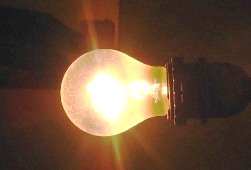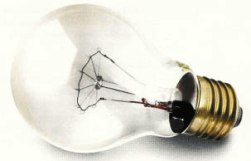Categories: Sharing experience, Sources of light
Number of views: 304585
Comments on the article: 59
Why do incandescent bulbs burn out so often
Five reasons for incandescent lamps to fail permanently and how to deal with it.
 Recently, very many began to face the problem of frequent burnout of incandescent lamps in their apartments. Incandescent lamps should last one thousand hours, but in reality they burn out much faster. And if ten years ago it was possible to put up with this bad phenomenon, since the lamps cost a penny, now it is already becoming a real problem. Prices for incandescent lamps are rising, and their life, alas, is constantly decreasing.
Recently, very many began to face the problem of frequent burnout of incandescent lamps in their apartments. Incandescent lamps should last one thousand hours, but in reality they burn out much faster. And if ten years ago it was possible to put up with this bad phenomenon, since the lamps cost a penny, now it is already becoming a real problem. Prices for incandescent lamps are rising, and their life, alas, is constantly decreasing.
The main reasons for the rapid failure of incandescent lamps:
1. Low-quality lamps
The quality of incandescent lamps of domestic production leaves much to be desired. For some reason, the most powerful small lamps burn out (up to 60W), just the ones that are most often used in lighting in everyday life). All domestic plants are approximately the same in quality. Of all domestic enterprises, the highest quality is considered the products of the Kalashnikovsky Electric Lamp Plant.
If earlier domestic lamps lost in quality, they won in price, then now, when there is no big price difference between local incandescent lamps and products of world lighting manufacturers (GE, Philips, Osram), preference should be given to the second group.
When buying lamps, you need to pay attention to several key features. See specific practical recommendations here - How to choose a quality incandescent lamp.
The only question is, are the lamps themselves to blame? Before we run to the store and buy imported light bulbs, let's pick it up multimeter and measure the voltage in your apartment, and it is advisable to measure it several times at different times of the day. This is in order to present the fullness of the picture.
2. High voltage in the apartment
 The main factor affecting the life of an incandescent lamp is the high voltage in the electrical networks in our apartments.
The main factor affecting the life of an incandescent lamp is the high voltage in the electrical networks in our apartments.
The service life of an incandescent lamp is very dependent on the quality of the supply voltage. With increasing voltage, the temperature of the tungsten filament increases, the tungsten atoms begin to evaporate intensively, the filament becomes thinner, the bulb becomes darker, and finally the filament breaks, i.e. increased voltage greatly reduces the life of the incandescent lamp. So, from the reference data, the deviation of the voltage from the nominal by only 1% reduces the lamp life by 14%.
What can be done if you have a steadily increased voltage in your apartment?
Firstly, you can use incandescent lamps for operating voltage 230 - 240 V (The stores also sell ordinary lamps with voltage of 220 - 230 V). Many manufacturers knowing the situation with voltage produce such lamps. Just when buying, you need to pay attention to what is written on the package and this may well solve the problem.
Secondly, it can be used instead of incandescent lamps compact fluorescent tubes. The increased supply voltage does not affect their service life in any way.
Thirdly, incandescent lamps can be connected through a specially electronic device called incandescent lamp protection unit. Such blocks protect incandescent lamps from power surges and provide them smooth startthanks to what lamps are protected from inrush currents at the moment of inclusion. The most popular blocks for protecting incandescent lamps are Granite from Nootechnika. Protection blocks are installed on each separate switch. If the controlled power is large, then the blocks can be mounted on the wall or installed on the ceiling.
 Fourth, you can buy Voltage regulator. It is most convenient to plan its installation at the repair stage and replacement of wiring in the apartment. Select the entire lighting network in one or several groups and put one voltage regulator on them.
Fourth, you can buy Voltage regulator. It is most convenient to plan its installation at the repair stage and replacement of wiring in the apartment. Select the entire lighting network in one or several groups and put one voltage regulator on them.
3. Bad contacts in the lampholders, burned lampholders
Most of the lampholders of domestic fixtures are made of plastic, and in inexpensive fixtures, plastic is not very high quality either. Ceramic cartridges are used very rarely. Use in plastic cartridges can only light bulbs with a capacity of not more than 40 watts, otherwise the cartridges begin to crack and burn out. In the process, the contacts in the cartridges are oxidized and burn. With poor contacts in the lampholders, the lamps additionally heat up and fail.
If your incandescent lamps constantly burn out in only one chandelier, a crack is heard periodically and the lamps spontaneously change brightness during operation, then the reason may be precisely due to poor contacts in the lamp holders.
Contacts can be cleaned, burned cartridges replaced, ideally, it is best to replace the lamp itself. Do not use lamps with luminaires larger than permissible according to the lamp passport!
 If you do not have enough light, switch to compact fluorescent lamps. Think, as a fanatical lover of incandescent lamps, we end up with a sticker on the "maximum 40 W" cartridges, which actually limits the luminous flux and lighting in our room. And using compact fluorescent lamps, the illumination in the room can be increased several times, while not exceeding the maximum thermal load on the cartridges and live parts of the lamp!
If you do not have enough light, switch to compact fluorescent lamps. Think, as a fanatical lover of incandescent lamps, we end up with a sticker on the "maximum 40 W" cartridges, which actually limits the luminous flux and lighting in our room. And using compact fluorescent lamps, the illumination in the room can be increased several times, while not exceeding the maximum thermal load on the cartridges and live parts of the lamp!
4. Poor or broken switch with burnt contacts.
A cause of continuous burning of incandescent lamps may be a poorly functioning switch. Disassemble the switch and look at the state of its contact elements (though not all switches have open contacts). Any switch has its own service life and must be changed periodically.
If the switch sparks (most often due to contact bounce), has carbon deposits in the contact area, or there are signs of blackening on the wires under the screws in the switch terminals, then this switch must be disposed of.
Often, it is possible to diagnose the cause of the burning of bulbs due to a switch without disassembling it based on the fact that lamps that are controlled by a single switch button constantly burn out.
When replacing the switch, it is advisable set dimmer, which will allow you to change the brightness of the light in the room and will protect the lamp from current surges at the time of inclusion.
5. Poor connection of the chandelier wires to the network or poor contacts in the junction boxes, apartment electrical switchboard.
Reliable operation of all electrical appliances in the apartment depends on the quality of the contacts in the wiring. Often the cause of lamp burnout is poorly made or weakened contacts at the junction of the wires. Especially often, such phenomena are observed when the wiring in the apartment is completed aluminum wire.
If none of the above helps to solve the problem of continuous burnout of incandescent lamps, then the matter is most likely in the contacts. It is necessary to diagnose all electrical wiring, starting from the point of connection of the lamp (especially pay attention to the blackened wires at the connection points) and tighten or redo the contacts everywhere.
Now a lot of different modern connectorsUsing which you can significantly improve the wiring in the apartment. If you do not have a special education and relevant work experience, then this work is best left on the shoulders of a familiar electrician.
In the comments I will be glad to hear stories from your experience in addressing the causes of frequent burnout of incandescent lamps!
See also at bgv.electricianexp.com
:
